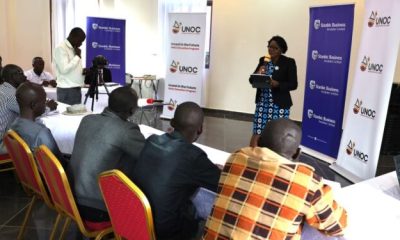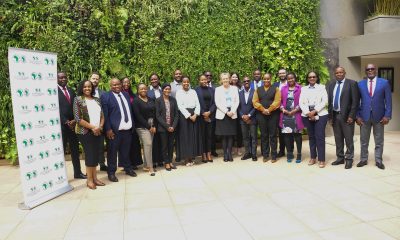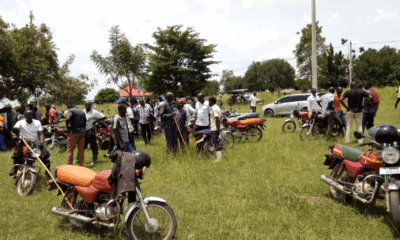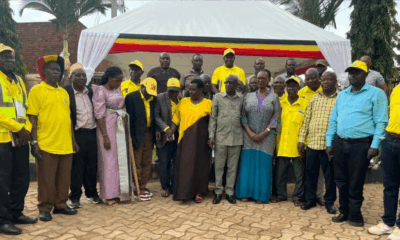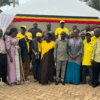News
Uganda revives silk production with a bang
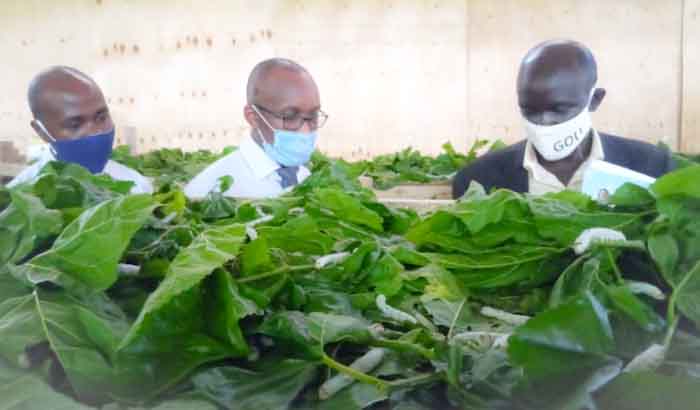
Dr. Clet Wandui Masiga explaining to a monitoring and evaluation team from the Ministry of Finance progress of the silkworm project
This time with plans to produce real silk clothes
More than 20 years ago, I visited a cousin in Kitemu, Wakiso district, located – about 8 kilometres along Kampala- Masaka road. Mrs. Kate Bbigita, had planted mulberry for feeding worms that produce silk cocoons which are processed to produce silk – one of the most expensive type of fabric in the world.
The mulberry trees had overgrown and were eating up her space for food crop production. She had also built a silk rearing house and demonstrated a lot of enthusiasm for the project.
Weeks turned into months of waiting for the silkworms, which eventually failed to materialise. Mrs. Bbigita eventually cut down the trees, to signal the still birth of yet another development project targeting poor people, alongside that of Moringa and Aloevera to name a few.
So when I saw pictures posted on the Facebook page of one scientist friend Dr. Clet Wandui Masiga, with an artistic impression of an impressive factory fitted with machines with a promising declaration to put Uganda on the global map for silk production, I got interested.
To cut the long story short, our conversation last week, forced me to jump into a taxi and eventually a boda boda that led me to the remote village of Namasumbi in Kyampisi sub-county, Mukono district.
Here, the Ministry of Science, Technology and Innovations led by Dr. Elioda Tumwesigye, has supported the establishment of the National Sericulture Resources Research and Development Centre to promote silk production around Mukono district.
As I later learnt, the Namasumbi centre, along with another one at Rubaare, Sheema, Bushenyi district, will support over a dozen smaller stations dotted across the country.
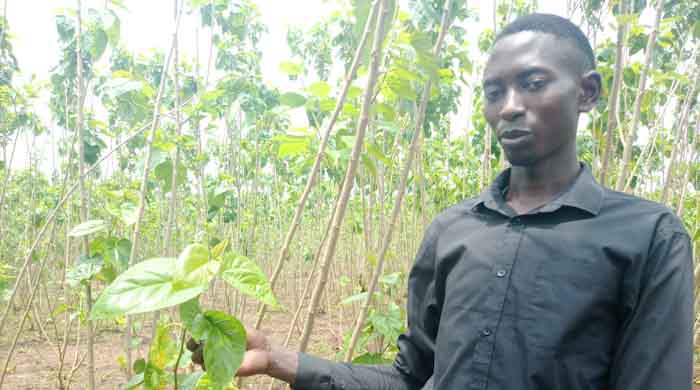
Emmanuel Wolimbwa explains the silkworm project
Emmanuel Wolimbwa, one of the caretakers of the centre, introduced me to the project and generally the whole concept of the revival of silk-production in Uganda, their plans and goals.
Wolimbwa said: “The Commercialisation of Sericulture Technologies and Innovations Project is one of the projects that was selected for funding under the Innovations Fund for 2017-2018.”
The brain-child of Dr. Clet Wandui Masiga – through his private company, the Tropical Institute of Development Innovations (TRIDI), the idea received a grant for a feasibility study which established that Uganda has enormous potential to use sericulture to industrialize.
The government agreed to support the idea by partnering with TRIDI to implement the project on sericulture.
According to Masiga, the government is expected to invest UGX750bn as the expected investment over a period of 5 years.
“That money shall help us put up at least 50,000 acres of mulberry gardens, install some processing equipment ranging from silk yarn spinning all the way to silk fabric. With that money, we shall be at take off stage,” Masiga says.
Already, he says about UGX10 billion has been invested into the project by both the government and TRIDI. This has supported the construction of the factory structures at Namasumbi and at Rubaare, established close to 1000 acres of mulberry gardens. They have also procured some factory equipment from China and recruit staff.
But Masiga expresses confidence that even if the government funding delays, they are determined to move ahead with the project.
“You see, government priorities keep changing. For us we are committed to the project and shall look for other partners, in case the expected funding does not materialize to ensure that the project progresses,” Masiga vowed.
With supervision from the Uganda National Council for Science and Technology (UNCST), implementation of the project has been relatively fast.
In less than six months, Wolimbwa, says the machinery that will process the silk from cocoons to yarn and then to silk cloth, will be installed at least at Namasumbi and in Sheema.
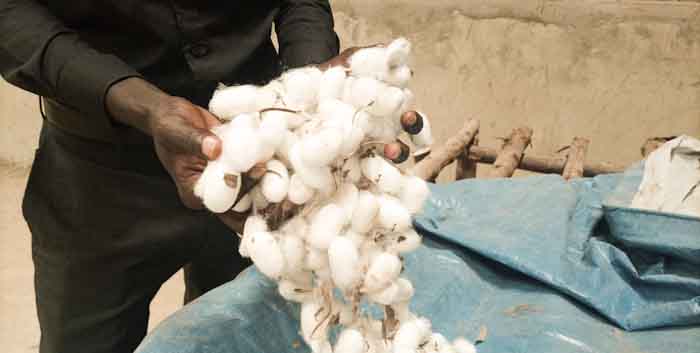
Cocoons produced by the silkworms
“I am certain that before June, some machines will already be here at (Namasumbi) and in Sheema,” said Wolimbwa.
Another semi-permanent silkworm rearing house has been erected and the silkworms already introduced to teach both the staff as well as the community the nitty-gritty ofsilk production.
And as seen from the mature 14-acre mulberry garden surrounding the plant, and the dozen or so people that include extension workers and support staff that have been employed, the project has generated a lot of optimism and excitement in the community that something possibly transformational is afoot.
The history of silk production in Uganda
As noted earlier, there have been numerous attempts to introduce silk production in Uganda before. According to Wolimbwa, most of these efforts were championed and promoted by non-governmental organisations such as the Japanese JICA.
“They focused mainly on cocoon production and lacked a reliable supply of eggs. Also they had very limited value addition and suffered from lack of government support to organise the industry around a value-chain model.”
For example, at Rubaare,the project is inheriting facilities of a defunct project that collapsed in 2007 after staggering for over 10 years.
Wolimbwa says of the challenges that faced the earlier effort in Sheema: “Exporting the cocoons from far-away places, proved costly since they are very light they needed a lot of space, which proved economically unviable to transport cocoons to export markets.”
This time however, Wolimbwa says, TRIDI’s has changed the model to focus on empowering farmers to add value to their silk by offering extension services to enable them learn how to rare silkworms, grow mulberry and care for the worms, and process the cocoons to different levels and then sell the value-added products.
Wolimbwa adds that they have also established several other centres in districts like Kween, Nwoya, Mubende around which clusters of silk farms will be developed to boost the project’s own production.
“Every district with a Sericulture Station will have at least a grainage (a specific facility that helps to produce silkworm eggs), a cocoon dryer, reeling and re-reeling,” says Wolimbwa.
“Currently we have over 1000 acres of mulberry planted or in waiting to be planted this coming season. In Nwoya for example, we have 100 acres planted. We have 50 acres planted in Kween and more than 85 acres planted in Mubende.
Our target to reach 50,000 acres of mulberry planted in five years.
The economics of silk production
According to Wolimbwa, silk production is a labour intensive but very lucrative venture, which perhaps suits Uganda’s ambitions of creating employment for many unemployed youth.
He says, a farmer can realise up to UGX15m from one acre of growing mulberry cultivation.
He adds that although they encourage different players to be interested in the different stages of the silk value chain, he advised farmers to get interested in the rearing stage to produce the cocoons.
He explains that a cocoon is a fibre produced by the larvae ofilkworm moth.
Wolimbwa says that if the farmers decides to sell, cocoons, the project will buy them from the farmers at UGX13000 and UGX20,000 per kilo for a wet kilo and dry kilo of cocoons respectively.
“A rearing cycle of silk worms takes 28 days. Factoring in the periods of disinfecting the rearing house, a farmer can have as many as 8 cycles in a year using the same house.
He adds that an acre of mulberry can help to raise worms that can produce between 35 to 50kgs of cocoons per rearing cycle.
“The harder part of silk production is establishing a reading house. But once this one is done, a farmer can get a return non-investment in the second year of production,” says Wolimbwa.
The initial high cost of establishing the mulberry garden and rearing house could prove a hindrance to farmers.
But Wolimbwa says the project hopes try to support farmers with mulberry planting materials, and possibly also subsidize construction of rearing houses for enthusiastic farmers.
Silk production is not without it’s challenges. Although the worms feed exclusively on mulberry, which helps to ensure they are not a threat to other crops, they are susceptible to predators like birds. So the rearing houses have to be built properl yat full maturity, just before the worms start to form cocoons.
The creatures have to be fed heavily and only on freshly harvested mulberry leaves.
“The leaves to be eaten in the morning are harvested very early. And those to be eaten in the night are harvested in the evening,” says Wolimbwa.
But the handsome rewards that come from silk production, including financial benefits, economic self-sustenance such as being able to meet the growing silk demand in the country, are probably worth the labour.
Comments







